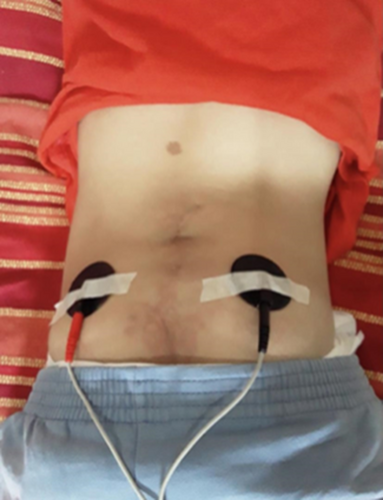Successful use of transcutaneous parasacral stimulation in a patient with myelomeningocele and fecal incontinence: A case report
Abstract
Myelomeningocele is a complex congenital defect that affects the spinal cord and structures associated with it. These patients often have neurogenic bowel and bladder dysfunction with constipation, fecal and urinary incontinence. In addition to dietary modifications, laxatives, and enemas, therapies such as biofeedback and neurostimulation (invasive and noninvasive) are sometimes used. These techniques are rarely available, may require surgical procedures, and are not devoid of complications. We present the case of a 13-year-old boy with myelomeningocele at the L4 level, with constipation, dyssynergic defecation, and fecal incontinence (FI). He was treated with biofeedback achieving partial improvement of FI, and then with transcutaneous electrical neurostimulation (TENS) with subsequent resolution of constipation and FI. To our knowledge, this is the first case report using neurostimulation with TENS applied to the S2–S4 dermatomes in a patient with myelomeningocele. This represents a safe, noninvasive, and low-cost treatment for these patients.
1 INTRODUCTION
Myelomeningoceles are complex congenital defects of the neural tube. These patients commonly have sensory and motor deficits as well as constipation and fecal/urinary incontinence in the setting of neurogenic bowel and bladder dysfunction. Dyssynergic defecation occurs when there is dyscoordination between the anal sphincter, and abdominal/pelvic floor muscles to facilitate defecation. It is a common cause of constipation in general population, but incidence in patients with myelomeningocele is not well studied.1, 2
Biofeedback is a behavioral learning therapy used for pelvic floor dysfunction. It uses visual, auditory, or verbal feedback prompting the user to contract and relax the anal sphincter in a coordinated manner. The American Neurogastroenterology and Motility Society recommends biofeedback therapy for the management of constipation with dyssynergic defecation in adults.1 Techniques such as neurostimulation are used in the management of patients with intractable constipation and fecal incontinence (FI). Sacral nerve stimulation is used as a first-line surgical treatment for adults with FI refractory to medical therapy. Its efficacy has been demonstrated in children with FI and constipation, but techniques are invasive and require an implanted electrode S3 foramina and a subcutaneous device, that requires periodic battery replacement. Other approaches for neurostimulation include posterior-tibial nerve stimulation and abdominal transcutaneous electrical stimulation; however, evidence of its efficacy in pediatrics is limited.3 We present a case using a noninvasive neurostimulation technique not previously reported in patients with myelomeningocele.
2 CASE REPORT
This is a 13-year-old male with a history of myelomeningocele (repaired at birth) with spinal cord injury at the L4 level, neurogenic bladder, constipation, and FI. He had overflow urinary incontinence and required clean intermittent catheterization (CIC). He had voluntary bowel movements every 48 h (Bristol 2–3) and FI once a day with urge to defecate every 15 days. On physical exam, the anal sphincter had a normal tone, and there was hard fecal matter in the rectal vault. He was also managed with enemas without achieving continence.
Initial anorectal manometry (ARM) at 8 years old had normal resting pressure of the anal sphincter and rectoanal inhibitory reflex (RAIR), with prolonged time returning to baseline pressure, consistent with our previously published work with MMC patients,4 decreased first sensation and dyssynergia at push maneuver (Table 1). He was managed with eight sessions of biofeedback using a balloon in the anal canal and software showing a ball and a ramp, with the ball going up with the contraction of the anal sphincter and traveling down with relaxation. Repeat ARM showed improvement of parameters in the push maneuver (Figure 1) and clinically, he had partial improvement with episodes of FI two to three times per week. He was subsequently managed with transcutaneous neurostimulation with biphasic, bipolar frequency of 25 Hz, pulse width of 250 ms, and burst frequency of 4 Hz. It was delivered using two adhesive electrodes applied at the S2–S4 level, between the posterior superior iliac spines (Figure 2). He received 12 weekly hospital-based sessions, using a transcutaneous electrical nerve stimulation device (transcutaneous electrical neurostimulation [TENS]). He continued using TENS at home twice per week, achieving daily voluntary bowel movements in the toilet and no FI. He also improved sensation in the anal/gluteal region. Repeat ARM improved the first sensation, the urge to defecate, and maximum tolerance. These changes have been sustained after 3 years. He also improved urinary continence, no longer requiring CIC.
| Manometry value | First presentation | After biofeedback therapy | After percutaneous sacral nerve stimulation |
|---|---|---|---|
| Anal sphincter resting pressure | 40 mmHg | 38 mmHg | 40 mmHg |
| Squeeze pressure | 73 mmHg | 68 mmHg | 64 mmHg |
| Push maneuver | Dyssynergic | Relaxation | Relaxation |
| RAIR | + | + | + |
| Duration of RAIR (20/40/60 mL) | 19/20/23 s | 21/22/20 s | 16/23/25 s |
| First sensation | 60 cc | 60 cc | 10 cc |
| First urge | 160 cc | 160 cc | 40 cc |
| Max tolerable volume | 180 cc | 160 cc | 130 cc |
- Abbreviation: RAIR, rectoanal inhibitory reflex.


3 DISCUSSION
Biofeedback therapy is sometimes used for the management of constipation and FI associated with dyssynergic defecation, especially in adult population.1 However, there is a subset of patients that only achieve partial response or no response. In patients with spinal lesions, the utility is less studied.
More recently, we studied the use of biofeedback treatment in pediatric patients with MMC, anorectal malformations, and refractory functional constipation. In this study, patients with MMC achieved complete continence in 57% and partial continence in 28%. We presented these findings at the XIII Latin American Congress of Pediatric Gastroenterology, Hepatology, and Nutrition.5
In the last decades, invasive and noninvasive techniques for neurostimulation have been developed. A study demonstrated efficacy of sacral nerve stimulation improving FI in children with intractable constipation.6 This surgical technique is costly and associated with complications including infection, leg discomfort and invasive procedures for removal.7
Recently, parasacral TENS has been used in children with urinary dysfunction and some adults with constipation showing good results. Parasacral TENS stimulates neuronal networks, triggering sacral reflexes and improving colonic motility.8 It has been studied in functional constipation, mainly in adults, with mixed results. Veiga et al. treated 14 children with urinary dysfunction and constipation with parasacral TENS to S2–S4. Sessions were given three times per week, and 85% reported improvement in constipation and abdominal pain, with a 100% improvement in urinary symptoms. There were no complications.9
In a randomized controlled trial in children with neurogenic bowel due to myelomeningocele that measured similar parameters, Kajbafzadeh et al. studied 30 children (15 with transcutaneous interferential electrostimulation and 15 with placebo), performing ARM before and 6 months after treatment. The treated patients required less volume to obtain the RAIR and had lower resting pressure, and improved constipation by 73%, with 53% showing sustained improvement at 6 months, showing significant differences compared to the placebo group (p < 0.01).10
Our patient had partial improvement with biofeedback, but continued having FI. FI has been associated with lower health-related quality of life in children with spina bifida, and this was the case in our patient.11 Therefore, we treated him with TENS, a noninvasive, inexpensive and readily available technique.
With this approach, he achieved full continence and improvement in push maneuver on ARM. This treatment was successful in avoiding the need for a surgical procedure that is prone to complications. Our case suggests that parasacral TENS can be easily and safely administered at home, and could be considered in the management of patients with myelomeningocele and constipation with FI before attempting invasive measures. This proposed strategy can benefit patients in whom biofeedback did not resolve symptoms and before invasive strategies. Studies assessing the efficacy of this approach in larger cohorts are needed.
CONFLICT OF INTEREST STATEMENT
The authors declare no conflicts of interest.
ETHICS STATEMENT
Written informed consent was obtained from the patient and family for the publication of this case.




